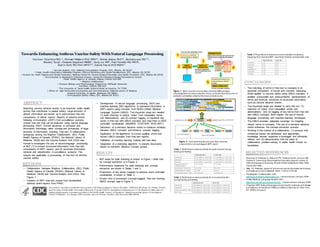
2006NIC-NLPPoster_V2
- 1. METHODS ABSTRACT Towards Enhancing Anthrax Vaccine Safety WithNatural Language Processing Herman Tolentino MD1,2 , Michael Matters PhD MPH2,3 , Wikke Walop PhD4,5 , Barbara Law MD4,5 , Wesley Tong6 , Deepak Sagaram MBBS7 , Fang Liu MS8 , Paul Fontelo MD MPH8 , Katrin Kohl MD PhD MPH9,10 , Daniel Payne PhD MSPH1 1 Vaccine Analytic Unit, National Immunization Program, CDC, Atlanta, GA 30333 2 Public Health Informatics Fellowship Program, Office of Workforce and Career Development, CDC, Atlanta, GA 30333 3 Division for Heart Disease and Stroke Prevention, National Center for Chronic Disease Prevention and Health Promotion, CDC, Atlanta GA 30333 4 Immunization & Respiratory Infections Division, Centre for Infectious Disease Prevention & Control Public Health Agency of Canada, Ottawa, Ontario K1A 0K9 5 Brighton Collaboration 6 Honours Biology and Pharmacology Programme, McMaster University Hamilton, Ontario L8S 4L8 7 The University of Texas Health Science Center at Houston, TX 77030 8 Office of High Performance Computing and Communications, National Library of Medicine National Institutes of Health, Bethesda, MD 20894 9 Immunization Safety Office, CDC, Atlanta GA 30333 Detecting vaccine adverse events is an important public health activity that contributes to patient safety. Large amounts of clinical information are locked up in unstructured free text components of clinical reports. Reports of adverse events following immunization (AEFI) from surveillance systems contain free text that can be analyzed using natural language processing (NLP). Current advances in computer and information technology allow storage and processing of large amounts of information, including free text. A collaborative workgroup among the Brighton Collaboration (BC), Public Health Agency of Canada (PHAC), the National Library of Medicine (NLM) and the Vaccine Analytic Unit (VAU) was formed to investigate the use of natural language processing or NLP (1) to extract structured information from free text components of AEFI reports, and (2) automate information retrieval and classification in surveillance systems. The outputs are applicable to processing of free text for anthrax vaccine safety. § Collaboration between Brighton Collaboration (BC), Public Health Agency of Canada (PHAC), National Library of Medicine (NLM) and Vaccine Analytic Unit (VAU). See Figure 1. § Creation of AEFI free text corpus from de-identified adverse event reports from PHAC. RESULTS CONCLUSIONS SELECTED REFERENCES § Development of natural language processing (NLP) and machine learning (ML) algorithms to represent information in AEFI reports using concepts from NLM’s Unified Medical Language System (UMLS). Two important steps are needed: (1) spell checking to reduce “noise” from misspelled words and abbreviations;; and (2) concept tagging to represent key words in free text with UMLS concepts and map them to AEFI controlled vocabularies (MedDRA, COSTART, WHO-ART). § Derivation of a semantic distance metric to measure similarity between UMLS concepts and enhance concept tagging. § Application of the algorithms to correct spelling errors and extract UMLS concepts from free text reports. § Validation of machine learning training with test data § Adaptation of a clustering algorithm to classify documents based on semantic distance concept groups. § NLP steps for spell checking is shown in Figure 1 while that for concept extraction is in Figure 2. § Performance measures for spell checking and concept extraction are shown in Tables 1 and 2. § Proportions of key words mapped to adverse event controlled vocabularies is shown in Table 3. § Screen shot of processed (concept-tagged) free text showing UMLS concept tags in Figure 2. § The matching of terms in free text to concepts is an essential component of human and machine reasoning. When applied to vaccine safety using UMLS concepts, it enables computable and unencumbered representation of terms and eventual extraction of structured information such as vaccine adverse events. § Two important steps are needed to carry this out: (1) reduction of “noise” from misspelled words and abbreviations, and (2) tagging of key terms from free text with UMLS concepts. Both require the use of natural language processing and machine learning techniques. § The UMLS provides adequate coverage for mapping clinical terms to concepts. The use of a semantic distance metric enhances the concept extraction process. § Working in the context of a collaboration (1) ensures that contextual issues are addressed and appropriate knowledge domain expertise is leveraged and efficiently utilized, and (2) demonstrates that the value of collaborative problem-solving in public health knows no boundaries. Figure 1. Spell checker process flow showing different steps. Disambiguation involves selection of one correction term from a list of potential candidates obtained from lexical dictionaries. Figure 2. Concept extraction process flow showing snapshot of a concept-tagged AEFI report Table 1. Performance measurements for spell checker during training and testing Table 2. Performance measurements for concept extraction during training and testing Table 3. Proportions of adverse event controlled vocabulary mappings from free text AEFI reports for training and test data sets This research was made possible through a grantby Oak Ridge Institute for Science Education (ORISE) to the Centers for Disease Control and Prevention Public Health Informatics Fellowship Program (PHIFP).Specialacknowledgments to (1) The Brighton Collaboration for making globalresearch connections possible;(2) the Public Health Agency of Canada for valuable source data inputs;(3) the National Library of Medicine for sharing UMLS expertise; and,(4) Herman’s mentors:Dan Payne and Mike McNeil. 1. Hripcsak G. Friedman C, Alderson PO, DuMouchel W, Johnson SB, Clayton P. Unlocking clinical data from narrative reports: a study of natural language processing. Annals of Internal Medicine. May 1995;; 122(9)-681-688. 2. Sittig DF. Potential impact of advanced clinical information technology on healthcare in 2015. Medinfo 2004: 11(Pt 2):1379-82. 3. The Brighton Collaboration. URL: http://www.brightoncollaboration.org. Last accessed: January 2006. 4. Unified Medical Language System. URL: http://www.nlm.nih.gov/research/umls/. Last accessed: January 2006. 5. Chapman WW. Natural language processing for outbreak and disease surveillance. In Handbook of Biosurveillance, Elsevier Inc, New York, NY (2005) (in press).
